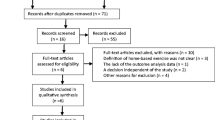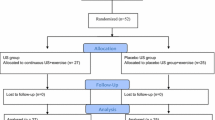Abstract
The objective of this non-randomised controlled trial was to evaluate the impact of group-based exercise programme and a home-based exercise programme on Bath Ankylosing Spondylitis Indices, depression and quality of life in patients with ankylosing spondylitis (AS). Approximately 41 patients in a rehabilitation unit were divided into two groups, either group- or home-based exercise programme. Exercise sessions were performed three times a week for a period of 6 weeks. The patients were compared before and after the rehabilitation programme, with respect to Bath Ankylosing Spondylitis Functional Index (BASFI), Bath Ankylosing Spondylitis Disease Assessment Index (BASDAI), Bath Ankylosing Spondylitis Metrology Index (BASMI), Beck Depression Inventory (BDI) and The Nottingham Health Profile (NHP). A statistically significant improvement was observed on BASDAI, BASMI and energy, pain, reaction of emotional and sleep subscores of NHP in both exercise groups after the exercise programme (p < 0.05). No statistically significant changes were detected in BASFI, BDI and social and mobility subscores of NHP in both exercise groups (p > 0.05). No statistically significant differences were found between the two exercise programmes (p > 0.05). Group and home-based exercise programmes are efficient in improving symptoms and mobility and had an important effect on quality of life in patients with AS. Home-based exercise programme, as it is cheaper, more easily performed and efficient, may be preferable for the management programme in AS.
Similar content being viewed by others
References
Lim HJ, Lim HS, Lee MS (2005) Relationship between self-efficacy and exercise duration in patients with ankylosing spondylitis. Clin Rheumatol 24:442–443
Dagfinrud H, Kvien TK, Hagen KB (2005) The Cochrane review of physiotherapy interventions for ankylosing spondylitis. J Rheumatol 32:1899–906
Analay Y, Ozcan E, Karan A et al (2003) The effectiveness of intensive group exercise on patients with ankylosing spondylitis. Clin Rehabil 17:631–636
Ince G, Sarpel T, Durgun B et al (2006) Effects of multimodal exercise program for people with ankylosing spondylitis. Phys Ther 86:924–935
Helliwell P, Abbott CA, Chamberlain MA (1996) A randomised trial of three different physiotherapy regimes in ankylosing spondylitis. Physiotherapy 82:85–90
Hidding A, van der Linden S, Boers M et al (1993) Is group physical therapy superior to individualized therapy in ankylosing spondylitis? A randomized controlled trial. Arthritis Care Res 6:117–125
Santos H, Brophy S, Calin A (1998) Exercise in ankylosing spondylitis: how much is optimum. J Rheumatol 25:2156–2160
Calin A, Garrett S, Whitelock H et al (1994) A new approach to defining functional ability in ankylosing spondylitis: the development of the Bath Ankylosing Spondylitis Functional Index. J Rheumatol 21:2281–2285
Karatepe AG, Akkoc Y, Akar S et al (2005) The Turkish versions of the Bath Ankylosing Spondylitis and Dougados Functional Indices: reliability and validity. Rheumatol Int 25:612–618
Akkoc Y, Karatepe AG, Akar S et al (2005) A Turkish version of the Bath Ankylosing Spondylitis Disease Activity Index: reliability and validity. Rheumatol Int 25:280–284
Garrett S, Jenkinson T, Kennedy LG et al (1994) A new approach to defining disease status in ankylosing spondylitis: the Bath Ankylosing Spondylitis Disease Activity Index. J Rheumatol 21:2286–2291
Jenkinson TR, Mallorie PA, Whitelock HC et al (1994) Defining spinal mobility in ankylosing spondylitis (AS). The Bath AS Metrology Index. J Rheumatol 21:1694–1698
Carr-Hill RA, Kind P (1989) The Nottingham Health Profile. Soc Sci Med 28:885
Kucukdeveci AA, McKenna SP, Kutlay S et al (2000) The development and psychometric assessment of the Turkish version of the Nottingham Health Profile. Int J Rehabil Res 23:31–38
Beck AT, Ward CH, Mendelson M et al (1961) An inventory for measuring depression. Arch Gen Psychiatry 4:561–571
Hider S, Wong M, Ortiz M et al (2002) Does a regular exercise program for ankylosing spondylitis influence body image. Scand J Rheumatol 31:168–171
Fankenbach A (2003) Disability motivates patients with ankylosing spondylitis for more frequent physical exercise. Arch Phys Med Rehabil 84:382–383
Uhrin Z, Kuzis S, Ward M (2000) Exercise and changes in health status in patients with ankylosing spondylitis. Arch Intern Med 160:2969–2975
Santos H, Brophy S, Calin A (1998) Exercise in ankylosing spondylitis: how much is optimum. J Rheumatol 25:2156–2160
Kraag G, Stokes B, Groh J et al (1994) The effect of comprehensive home physiotherapy and supervision on patients with ankylosing spondylitis—an 8-month follow-up. J Rheumatol 21:261–263
Pedersen BK, Bruunsgaard H, Klokker M et al (1997) Exercise-induced immunomodulation–possible roles of neuroendocrine and metabolic factors. Int J Sports Med 18(Suppl 1):S2–S7
Viitanen JV, Heikkila S (2001) Functional changes in patients with spondylarthropathy. A controlled trial of the effects of short-term rehabilitation and 3-year follow-up. Rheumatol Int 20:211–214
Sweeney S, Taylor G, Calin A (2002) The effect of a home based exercise intervention package on outcome in ankylosing spondylitis: a randomized controlled trial. J Rheumatol 29:763–766
Fernandez-de-las-Penaas C, Alonso-Blanco C, Morales-Cabezas M et al (2005) Two exercise interventions for the management of patients with ankylosing spondylitis. Am J Phys Med Rehabil 84:407–419
Heikkila S, Viitanen JV, Kautiainen H et al (2000) Sensitivity to change of mobility tests; effect of short term intensive physiotherapy and exercise on spinal, hip, and shoulder measurements in spondylarthropathy. J Rheumatol 27:1251–1256
Da Costa D, Dritsa M, Ring A et al (2004) Mental health status and leisure-time physical activity contribute to fatigue intensity in patients with spondylarthropathy. Arthritis Rheum 51:1004–1008
Author information
Authors and Affiliations
Corresponding author
Rights and permissions
About this article
Cite this article
Karapolat, H., Akkoc, Y., Sarı, İ. et al. Comparison of group-based exercise versus home-based exercise in patients with ankylosing spondylitis: effects on Bath Ankylosing Spondylitis Indices, quality of life and depression. Clin Rheumatol 27, 695–700 (2008). https://doi.org/10.1007/s10067-007-0765-0
Received:
Revised:
Accepted:
Published:
Issue Date:
DOI: https://doi.org/10.1007/s10067-007-0765-0




